|
To help navigate through the information contained here,
you can read the information in its entirety by scrolling through the page,
or use the choices below to go directly to the section of interest.
AVOIDING ISSUES: Protecting Yourself · The Hazardous Four H's · Avoiding Issues with the Physical Environment · Avoiding Flora and Fauna Issues · Protecting Your Food · Protecting Your Gear
Hit the Trail (Go...)
The planning is done. The preparations have been made. You're ready. Now it's all a matter of applying some basic skills, dealing with what the environment will throw at you... And, following the rules. Rules put in place by the Park Service, as well as the rules of common sense. This page is intended to provide an overview of basic trail skills, challenges the environment might toss your way, and oh yes, the rules. Might as well start with those...
Trail "Rules" (Also see the "Leave No Trace" page)
Stay on the Trail: Do not cut across switchbacks or take shortcuts.
- This is damaging to the fragile terrain and creates trail confusion for other hikers.
- It also creates a potential rock fall hazard for hikers traveling on lower sections of the trail.
- Respect cryptobiotic soils – Stay off them... Don't bust the crust!
Note on Cryptobiotic Soils: 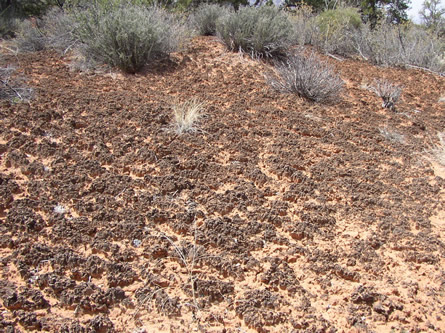 Common to the Esplanade, these are areas of ground with a dark, crusty, and caked appearance. They are made up of a community of cyanobacteria, lichens and mosses that serve to stabilize easily eroded desert soils and increases the ability of the soil to retain moisture. This makes for greater infiltration of precipitation and increases fertility by fixing nitrogen and adding carbon to the soil. Over a long period of time, this creates soil that is capable of supporting other more complex plants. These soils are hundreds of years in the making and are extremely fragile. Trampling through them inflicts damage that takes a very long time to repair. Common to the Esplanade, these are areas of ground with a dark, crusty, and caked appearance. They are made up of a community of cyanobacteria, lichens and mosses that serve to stabilize easily eroded desert soils and increases the ability of the soil to retain moisture. This makes for greater infiltration of precipitation and increases fertility by fixing nitrogen and adding carbon to the soil. Over a long period of time, this creates soil that is capable of supporting other more complex plants. These soils are hundreds of years in the making and are extremely fragile. Trampling through them inflicts damage that takes a very long time to repair.
Don’t Throw Stuff into the Canyon: Particularly rocks. Don't roll them off of cliffs either. For those of us kids who are now past 50 years of age, resist the urge the best you can out of respect for the safety of others. Yes, we know that it's hard.
Help Others in Need: If you encounter someone in trouble, help them. As a variation, you could throw rocks at them… They’re already in trouble. But, we recommend the former.
Protect Water Sources: Camp at least 100 feet from water sources
- Set up camp at least 100 feet from water sources - Arizona State law requires campsites to be a quarter mile distant from water sources, but looks like the National Park Service trumps that.
- Use of soap in creeks is prohibited. We’re pretty sure this extends to Soap Creek… when it’s flowing.
No Fires: Other than those emanating from a backpacking stove. No fires would also extend to the burning of toilet paper.
Use Toilet Facilities When Available: Privies and composting toilets are available in Corridor campgrounds and in many Threshold areas. Use them. Otherwise, deposit human waste in a cat-hole 6-8 inches deep and not less than 300 feet distant from water sources and washes. And, pack out your used toilet paper.
Pack-In/Pack-Out: Your trash that is.
- This includes packaging, uneaten food, cigarette butts, grease, etc.
- Use a couple large freezer strength zipper-lock plastic bags to seal your trash for packing out.
- Make it a practice to pick up after other hikers as you happen across trash left on trails and at campsites.
- Remember the Boy Scout maxim to, "Leave your camp in better condition than it was in when you arrived."
No Graffiti: Sorry, the practice was banned shortly after the ancestral Puebloans completed their work and vacated the premises… Archaeologists suggest that one of the reasons they left the Canyon was the decline of the neighborhood, as evidenced by, you guessed it, all the graffiti and gang tagging.
Don’t Feed the Animals: They say, “Fed is Dead.” Animals habituated to food offerings from humans often end up starving when faced with finding food on their own.
Keep Your Hands to Yourself: No digging up, collecting or removing of plants, animals, rocks, or other natural or cultural features. Like your pack doesn't weigh enough?
Report Rare Sightings: If you make a positive identification of a rare sighting (e.g., mountain lion, feral burro, apparently undiscovered archaeological site) fill out a Natural History Observation Card, which are available at the Backcountry Information Center. Note: It is safe to say that rare sightings do not include bizarre behavior by group members. You can however fill out a card if you must.
Remote Water Sources: If you discover a previously unreported water source or can provide information on availability of seasonal water in the more remote sections of the Canyon, the Backcountry Information Center appreciates getting those updates to pass on to other hikers.
No Swimming in the Colorado River: It's inviting when temperatures are 115° F in the shade, but it's COLD, swift and can be deadly.
Going Rogue: Departing from the itinerary defined in your Backcountry Permit is prohibited. Also, please report any "Sarah Palin Sightings" to the Backcountry Information Center. Whether armed or unarmed, she is considered dangerous.
Fishing: Requires an Arizona state fishing license and trout stamp. Avoid dry canyon bottoms and washes, unless dry-fly fishing.
| To Top |
Hiking Techniques
“Shuffle” Down/”Rest” Up:
- On the descent, shuffle your steps in the steeper sections. It helps prevent locking your knee joint on each transition, which can increase knee soreness and fatigue.
- On the ascent:
- “Polepole” – Slowly, slowly.
- Use the “Rest Step”—A technique used by climbers when ascending steep slopes.
- It involves straightening and gently locking the knee of the most weighted, and trailing leg as the more relaxed transitioning leg is being brought forward for the next step.
- The gentle locking of the knee allows the climber to rest their weigh on their skeleton briefly, thereby giving some relief to the leg muscles in that weighted leg.
- That small amount of relief becomes very significant, from a fatigue standpoint, over the course of a long climb.
- If you’re pushing yourself too hard and get out of breath, it’s an indicator that your body isn’t getting enough oxygen. It will create more metabolic waste products under these conditions that build up in muscles leading to more rapid fatigue.
Got it Made in the Shade:
- Avoid hiking during the hottest part of the day -- Between 10 a.m. and 4 p.m.
- Wait for the shade
- Consider predawn starts and early evening finishes. A headlamp becomes a critical piece of gear to bring.
- The further down into the Inner Canyon you go the hotter it gets.
- High heat affects hiking efficiency. The result can be a halving of the distance you might normally travel in a day.
Enjoy it When You've Got It: Water, that is...
- When hiking in the heat, and anytime for that matter in the Canyon, take advantage of an available water source.
- Tank-Up - Hydrate while there and pre-hydrate before heading out.
- Cool-Down - Drench your clothing with water for its cooling effect.
Consider the Rank-and-File:
- Have the most experienced hikers at the front and rear of the team
- The front hiker sets the pace, seeking to prevent the team from getting too strung out. They become the “polepole” metronome during the ascent.
- The rear hiker or “sweeper” is intended to help sustain the pace of slower hikers and prevent them from falling too far behind.
- When a slower, inexperienced hiker begins to fall behind it can have a significant negative effect on their overall mental attitude.
- If that occurs, it is likely that their pace will slow further. This can put the entire team at risk when trying to reach a destination before encountering the hottest part of the day.
- The rear hiker is also the default “break-caller” as they have the best vantage point to assess overall team performance.
- Never leave a sick or injured member alone.
Eyes Front:
- When hiking, keep your eyes on the trail and about 3 to 6 feet ahead.
- Stop, if you want to take a good look around.
- The few seconds when you stop paying attention to where you’re putting your feet are exactly when you will trip, slip or lose your balance and fall. There are a lot of places on the trail that falling is a very bad idea.
Use Trekking Poles: Not only do they provide another way to relieve the stress being placed on your muscles and joints, they also help with balance and catching yourself before a trip or slip can become a fall.
Take a Break:
- A welcome relief and in the long-run their advantages outweigh the perceived need for speed.
- Once an hour for 5-7 minutes is sufficient
- Find some shade, sit down, prop your legs up, eat and drink.
- Take your boots off every other break to let your feet and socks dry out.
- Breaks of this length will help flush out 20 – 30% of the accumulated metabolic waste products that have built up in your legs while hiking.
- In the long run, breaks will not reduce your overall progress.
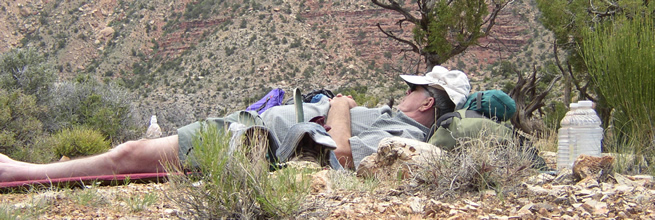
"Mother Goose" Demonstrating Proper Break Technique
Rules of the Road (or Trail):
- Uphill hikers get the right-of-way.
- Mules always have the right-of-way:
- Step off the trail to the uphill side and away from the edge of the trail dropping into the Canyon.
- Follow the wrangler’s directions, remain quiet and stand still.
- Don’t return to the trail until the last mule is 50 feet (15 meters) past your position.
- Mules ignore ALL of the toilet-behavior rules noted above.
| To Top |
Avoidance Behaviors
Protecting Yourself:
- “Hot Spots”: That feeling in your foot that something's just not quite right. It’s your foot’s way of saying, “Stop and figure out what’s wrong, before I make your next few days miserable.” Don’t procrastinate. Addressing issues early prevents them from becoming problems later. Things to check:
- Socks:
- Check for “bunching” or a crease that needs to be stretched out.
- Pull out the toe of the sock if it’s too tight across the toes.
- Is a seam in the sock causing discomfort? If so, readjust.
- Are they full of moisture? If so, change them.
- Have at least one extra pair of socks to allow drying from one day to the next.
- Rinsing socks out and carrying them on the outside of your pack allows them to dry out prior to reaching your next camp.
- Boot Lacing: Very important and often overlooked.
- There is not one proper way to lace, it’s a personal preference.
- Play around with the adjustments and lace for comfort while maximizing heel lock into the back of the boot, so as to minimize slippage of the foot inside the boot.
- Avoid lacing so tight that it restricts circulation.
- Stop after the first mile or so and re-lace after the boot has had a chance to loosen up.
- Using a double over-hand knot at the instep and for each of the speed-lacer lugs works wonders to help keep the foot in the desired position and resists loosening of the laces while hiking.
- Boots – Is a seam rubbing you the wrong way? If sock and lace adjustments don’t do it, try putting a piece of duct tape over the offending spot on the inside of the boot.  Using a much larger piece of tape than truly required often helps eliminate the problem of a smaller piece becoming dislodged when putting your foot into the boot or through movement while walking.
- If all of this fails and the hot spot is still there, slap a piece of duct tape over the place on your foot where the issue seems to be. The slick outer surface of the tape typically prevents a blister from developing. Ditto on using a piece that might be larger than necessary.
- Sunburn:
- Hat (wide-brimmed or ball cap with a back-flap to cover the neck)
- Long sleeves
- Sunscreen – Liberal application to ALL exposed skin.
- Sun Glare: Sunglasses (Polarized w/ 100% UV protection)
Be aware of the Hazardous Four H’s: (not to be confused with the animal husbandry organization)
- Heat Exhaustion: Brought on by dehydration and strenuous activity under high heat conditions
- Symptoms:
- Moist clammy skin
- Headache
- Weakness
- Dizziness
- Dilated pupils
- Possible vomiting
- Treatment:
- Get into the shade
- Lie down, elevate legs and rest
- Wet the victim’s clothing for added cooling
- Drink water with an electrolyte mix
- Eat high energy foods
- Heatstroke: More serious condition that can result in death. A likely escalation of heat exhaustion, driven by a shutting down of the body’s ability to produce sweat. This prevents cooling and results in an unsafe rise in core body temperature.
- Symptoms:
- Dry, hot skin.
- Redness in face.
- Dry armpits.
- High body temperature.
- Unconsciousness.
- Treatment:
- It is imperative to lower the victim’s body temperature.
- Get them into the shade.
- Begin cooling the body immediately (wet clothing, fan the victim).
- Get help.
- Hyponatremia (a.k.a, Water Intoxication): Over-consumption of water and loss of bodily salts as a result of insufficient intake of food.
- Symptoms:
- Similar to heat exhaustion
- Nausea
- Vomiting
- Confusion
- Frequent urination
- Treatment:
- Eat salty foods
- Get help if alertness decreases
- Hypothermia: Brought on by being damp/wet and exposed to cold and windy conditions. Most common when air temperatures are between 30° and 50° F. (-1° – 10° C.). Evaporative cooling drives the core body temperature down and below safe levels.
- Don’t be fooled by the Canyon residing in Arizona. Or, by all the precautions above about “Heat”. The weather conditions in the Canyon are highly variable and the danger of hypothermia is very real.
- Symptoms:
- Shivering (sustained and progressing to more violent and uncontrollable).
- Speech issues (e.g., slow, slurred, incoherent).
- Stumbling
- Exhibits poor judgment.
- Treatment:
- Seek shelter from the wind.
- Get the victim warm (Put on dry clothes/extra clothing, get them into a sleeping bag, use skin- to-skin contact in severe cases).
- Have them drink warm/hot fluids.
- Keep them awake if the case is severe.
- Heatstroke and Hypothermia related rescues have been documented as occurring on the same day in the Grand Canyon, attesting to the highly variable conditions that can be experienced there.
| To Top |
Avoiding Issues with the Physical Environment:
- Lightning:
- When it’s in the area, avoid open spaces, cliff bases, ridges, shallow caves, overhangs alcoves and lone trees.
- Seek out forests and brush thickets of uniform density, boulder fields or low lying areas, as they offer better protection.
- Flash-Flooding:
- Stay out of tributary canyons, creeks and drainages during the July and August monsoons.
- Beware aware that the flash-flood causing storm does not need to be in your immediate vicinity. It could be miles away and still cause flooding in your area.
- If you must travel through them, be mindful of potential escape routes during foreboding weather.
- Avoid camping in canyon bottoms and dry washes.
- If you have to camp near a wash, look for the “debris line” from previous floods and camp above it.
- Rock-Falls:
- Be aware of fall-lines and avoid them. They have the appearance of natural chutes that channel rock and debris down the sides of canyon walls. Darkened cliff faces, obvious water pour-over sites that channel rain run-off, are a type of fall-line.
- Rock-falls can also result from other travelers hiking above your position.
- Use careful hand and foot placement to avoid creating them for others. If you initiate a rock-fall, call out, “Rock,” as a warning if others are below.
- Creek Crossings:
- During spring runoff do not attempt to cross:
- Saddle Canyon Creek (Below Mauve Saddle)
- Shinumo Creek
- Tapeats Creek
- Pick your spot:
- Look for shallower crossing points.
- Avoid areas where the flow is constricted. These make the current stronger.
- What’s downstream? Anticipate a potential fall and assess whether the immediate stretch downstream would allow you to recover and exit.
- Trekking poles can add stability.
- Unbuckle waist belt and sternum strap to facilitate getting out of your pack should you fall.
- Cross as a group, arms linked.
- No ropes unless experienced in their usage for traverses
- If you fall and the water is to deep or swift for an immediate recovery:
- Rotate onto your back, ditch your pack and assume the “defensive swim position” – Head upstream, knees bent, feet up and as close to the top of the water as possible.
- Avoid foot entrapment, the leading cause of drowning in swift water. This is caused by attempting to stand up or pushing off the bottom with your foot in a strong current. If your foot gets wedged under or between rocks, the current will push your body forward and under water. Your strength will be insufficient to extricate yourself from this position.
- Paddle toward slower moving water before putting your feet down.
- Colorado River Crossings:
- Don’t do it, that’s what the bridges are for.
- If your route requires a crossing, and you don’t happen to be on the Bright Angel or Kaibab trails, to use the bridges, then hitch a ride across by flagging down a river company raft. You might be able to talk them into it, although the Park is trying to discourage this practice.
- Pack rafting has become a popular way to address crossings in backcountry areas outside of the Canyon. Use them only if you have previous experience and only do so in flat sections with ample distance between the crossing point and whitewater.
- The River is swifter than it may appear in flat sections.
- It’s also extremely cold 45°–50° F. (7-10° C.). Yes, in the summer too.
- Perhaps obvious, but be sure you can pick up a trail on the other side.
| To Top |
Avoiding Issues with the Flora & Fauna:
- Cactus & Agave: Can cause painful punctures.
- It seems that hardly a trip goes by without being stabbed in the shin by an agave spine. Long pants don’t help much under these circumstances. Try to avoid them, but expect to be stabbed when you least expect it.
- Cactus spines are fairly easy to remove with a pair of pliers or tweezers… One reason to carry a Leatherman® into the Canyon.
- Getting rid of the “glochids” is a bit more difficult. These are the tiny hair-like spines that are much harder to see. You can sense they are there, but finding their specific location by gently passing your fingers over the site has a tendency to just drive them further into the skin. The easiest way to remove them is to use your trusty duct tape.
- Cactus spines also have a tendency to make their way through the mesh fabric being used on a lot of today’s lighter weight hiking boots. And, man is that painful. The tops or your feet are not accustomed to such abuse. And more often than not it seems, a stop is required to take off boots, locate and remove the offending needles.
- Snakes: Let’s get this one out of the way…
- Yes, there are rattlesnakes in the Canyon.
- Varieties include: the Great Basin (Crotalus oreganus lutosus), Hopi (Crotalus viridis nuntius), Mojave (Crotalus scutulatus scutulatus), and of course, <cue the drum-roll> the Grand Canyon Pink rattlesnake (Crotalus oreganus abyssus).
| The Big Four: |
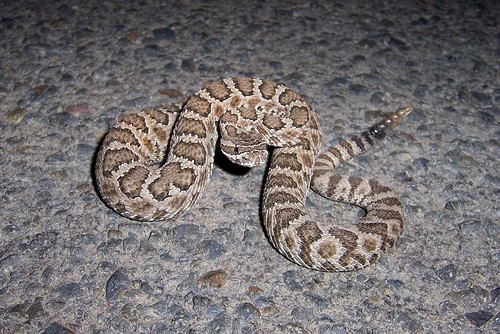 |
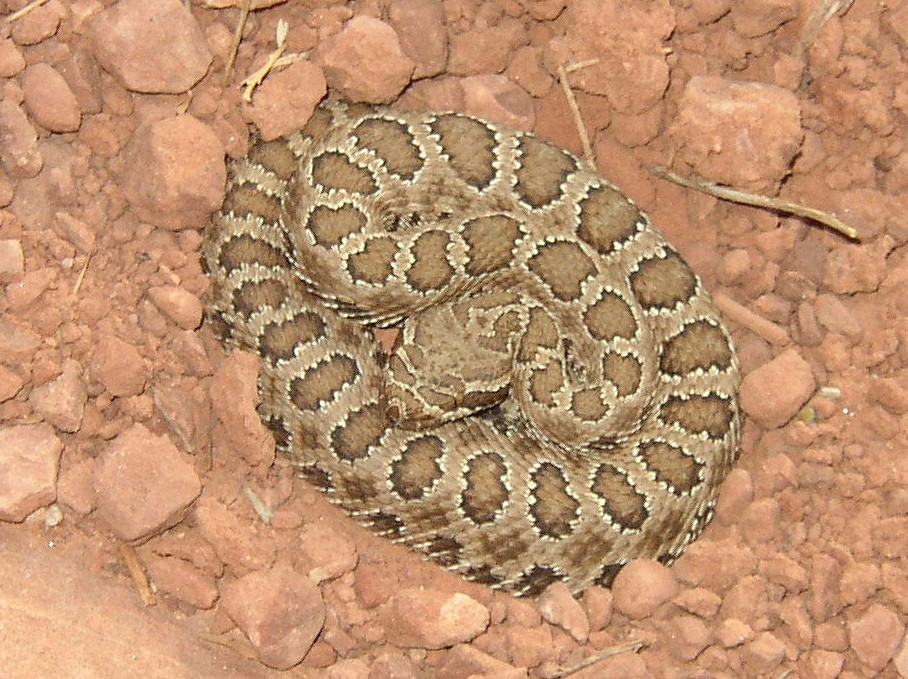 |
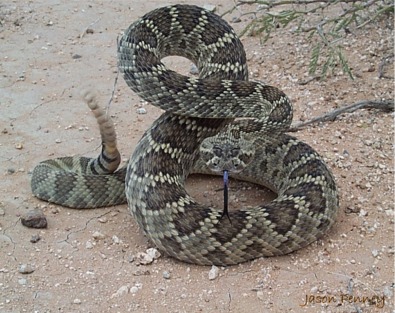 |
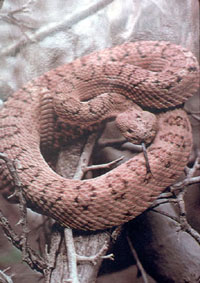 |
Great Basin Rattlesnake
[Photo Courtesy of www.freesnake.com] |
Hopi Rattlesnake
[Photo Courtesy of Wild Geese Gallery] |
Mojave Rattlesnake
[Photo Courtesy of Jason Penney] |
Grand Canyon Pink
[Photo Courtesy of NPS] |
- These are the only poisonous snakes in the Canyon. While these four are the most common, other varieties are present. The sitings are just much less frequent.
- Bites are rare and generally result from attempts to handle snakes. Leave them alone and they will generally leave you alone.
- Snakebite Treatment -- Highly varied opinions, but the prevailing advice seems to be:
- Have the victim remain quiet
- Splint the area of the bite, if an extremity.
- Cutting, sucking, freezing and use of tourniquets do little to stop the body’s absorption of venom, and tend to do more damage than good.
- Drink large volumes of fluids, avoiding alcohol.
- Send a team member out to arrange rescue.
- The sooner medical treatment can be delivered the better. These bites are typically not immediate response type issues and death is rare. Even with a severe bite, an individual can survive 24 to 48 hours.
- Other common non-poisonous species include: the Desert Striped Whipsnake (Masticophis taeniatus taeniatus); Great Basin Gopher snake Pituophis melanoleucus); Western Long-Nosed snake (Rhinocheilus lecontei); California Kingsnake (Lampropeltis getulus); Wandering Garter snake (Thamnophis elegans) and a couple of subspecies of Glossy snakes (Arizona elegans).
- Any bites from non-poisonous species should be treated as if the potential for a severe infection exists.
- Scorpions, Spiders & Ants: Scorpion stings, and spider and ant bites are more common than snakebites. They are painful, but rarely serious from a medical standpoint. The sting from a bark scorpion is the worst. Things to do to avoid stings and bites:
- Watch where you place your hands and sit.
- Don’t unroll your sleeping bag until you’re ready to use it, or shake it out before climbing inside.
- Shake out boots and clothing left out before donning.
- Treatment for stings and bites:
- Wash affected site and tough it out.
- If swelling is severe or pain is persistent; rest, apply hydrocortisone and take a Benadryl® (Diphenhydramine) capsule.
- Rodents: Carry a number of potentially hazardous diseases (e.g., Hantavirus), Because the virus is spread through inhalation of airborne particles from droppings, via blood, urine and saliva, be mindful if your campsite has signs of a high rodent presence (e.g., nests, droppings, visual sightings).
- Store food outside of tents and in a fashion to prevent mice from gaining access to it (See the section on “Protecting Your Food,” below).
- If there is evidence that mice, or other critters have gotten into your food, don’t eat it. Pack it out for disposal.
| To Top |
Protecting Your Food:
- Common Canyon Food Raiders Include: Mice, rats, chipmunks, squirrels, skunks, ringtails, and ravens. Not to mention the occasional neighboring hiker who covets your backcountry gourmet fare, wine, cocktails or cigars.
- In Corridor campsites, ammo cans are provided for food storage. Use them.
- In other camps hang food as you would a “bear bag.”
- Trees that will put more than 10 feet between your food and the ground are few and far between. So, you’ll need to locate whatever trees, bushes or overhanging rock ledges you can find from which to suspend your bag.
- Generally, hanging a food bag at least 4 feet off the ground will do the trick. The goal is to hang it such that a critter can’t just climb up whatever it is you’ve got it hanging from, reach out and gain access to your chow.
- To avoid mice, rats, ringtails and other smaller critters from performing a high-wire act over and down to your food bag, use fishing line instead of cord. It’s finer, slippery and more difficult for smaller raiders to grab onto. Use at least 12 feet of 20 lb. test line, but we’ve found 30 or 50 lb. test to be easier to manage. Add a couple of dropper loops and snap-swivels and you’ll have a rig that is useful under most conditions. Just wind it around a small piece of cardboard or plastic to keep it from tangling.
- Type of Food Bag to Use:
- Generally, any stuff sack will do. Particularly if the food you're placing inside is in individual plastic storage bags. While rain is unlikely, you want to protect your food from becoming soaked should a rainstorm come along.
- Unfortunately, nylon stuff sacks aren't gnaw-proof should one of the denizens of the night successfully gain access to your suspended food bag.
- Good news... No need to lie awake in camp wondering if that noise you heard was a Bushy-Tailed Wood Rat doing some grocery shopping. There are a couple of lightweight stainless steel mesh “cache bags” available that do an excellent job protecting whatever to put inside them from gnawing mouths.
- These bags should still be hung, since that avoids a persistent sustained assault on the contents. You’ll still need to ensure the contents are packed to be resistant to rain, but these are the food bags to use in the Canyon.
- Sizes include: Small (18"x14", ~8.0 oz.); Medium (18"x19", ~11.5 oz.); and Large (18"x24", ~15 oz.).
- Prices range from about $30 to $45.
- A "small" is large enough to handle one person's food for a 4 to 5-day trip.
| To Top |
Protecting Your Gear:
- Residual odors and the mere association of packs and other camping gear with the prospect of food, is enough to attract hungry critters even when your food is removed and properly stowed.
- Whether you hang your pack or lay it on the ground in camp, leave all zippered or otherwise sealed compartments open. It allows critters to readily explore your gear without having to chew through it to conduct their investigation.
- I don't recommend leaving your tent open with the same thoughts in mind though... Especially, if the intent behind bringing it was to put some nylon between you and the local inhabitants.
| To Top | |
 WildGeeseAdventures.com
WildGeeseAdventures.com 

 Common to the Esplanade, these are areas of ground with a dark, crusty, and caked appearance. They are made up of a community of cyanobacteria, lichens and mosses that serve to stabilize easily eroded desert soils and increases the ability of the soil to retain moisture. This makes for greater infiltration of precipitation and increases fertility by fixing nitrogen and adding carbon to the soil. Over a long period of time, this creates soil that is capable of supporting other more complex plants. These soils are hundreds of years in the making and are extremely fragile. Trampling through them inflicts damage that takes a very long time to repair.
Common to the Esplanade, these are areas of ground with a dark, crusty, and caked appearance. They are made up of a community of cyanobacteria, lichens and mosses that serve to stabilize easily eroded desert soils and increases the ability of the soil to retain moisture. This makes for greater infiltration of precipitation and increases fertility by fixing nitrogen and adding carbon to the soil. Over a long period of time, this creates soil that is capable of supporting other more complex plants. These soils are hundreds of years in the making and are extremely fragile. Trampling through them inflicts damage that takes a very long time to repair.


